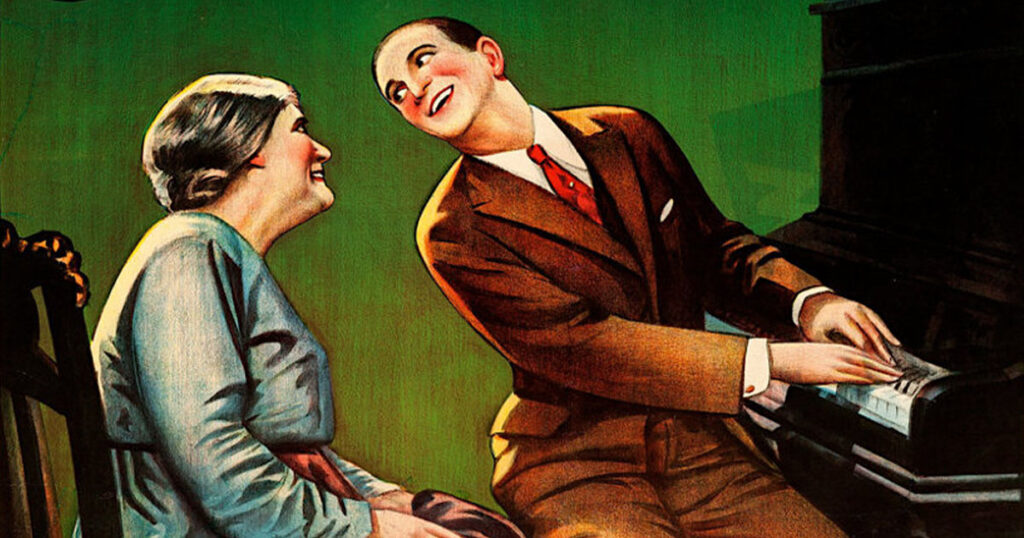
Only in America: Al Jolson and The Jazz Singer by Richard Bernstein; Knopf, 272 pp., $28
After crooning “Dirty Hands, Dirty Face,” Jack Robin (né Jakie Rabinowitz) turns to his audience in a scruffy cabaret called Coffee Dan’s. “Wait a minute, wait a minute, you ain’t heard nothin’ yet,” he says. “Wait a minute, I tell ya. You ain’t heard nothin’.” It is a metafictional moment early in The Jazz Singer (1927), as Al Jolson, playing Jack and breaking through the fourth wall, signals a revolution in the history of cinema. In the first feature film with synchronized sound, the theater audience is now able to hear something.
Jolson deserves to be remembered as the star of the pioneer talkie, but though he was the most popular and reputedly the highest-paid singer of the 1920s, when few challenged his self-designation as “the greatest entertainer in the world,” he has faded into obscurity. Bing Crosby, Frank Sinatra, and Elvis Presley have managed to outlive their eras, but Jolson’s melodramatic, often maudlin performances have not aged well. A century later, Jolson survives mostly as a cultural embarrassment. He performed often in blackface, and where fans once cheered, we now are likely to cringe.
Richard Bernstein, a veteran foreign correspondent with Time and The New York Times, begins Only in America with some personal details. Like Jolson, Bernstein, too, hailed from a family of Jewish immigrants from the Russian Pale of Settlement that also suffered hostility between generations. Bernstein wants to argue that in embodying conflicts between father and son, Old World and New, tradition and modernity, sectarianism and assimilation, Jolson captured something essential about the American experience, something unique to the United States.
The Jazz Singer is the story of a young man who, groomed as the successor to a dynasty of cantors, breaks his father’s heart by leaving home to pursue a career as a popular entertainer. Many years later, on the eve of a breakthrough—opening night for his lead role in a new musical—Jack/Jakie learns that his father is mortally ill. It is Yom Kippur, the holiest day in the Jewish calendar, and the father’s dying wish is that his prodigal son take his place to perform the sacred Kol Nidre at his synagogue. Jack’s dilemma mirrors that of many New World children: Should he honor the past when it means sabotaging his future? For a family of immigrants, must pursuing the American dream mean patricide?
The Jazz Singer is clunky and corny, worthy of its place in the National Film Registry for historical rather than aesthetic reasons. “The movies changed forever that night,” writes Bernstein about the film’s opening at the Warner Theatre on Broadway. “So did America.” The fact that this piece of cinematic schmaltz has been remade three times—in 1952 with Danny Thomas, in 1959 with Jerry Lewis, and in 1980 with Neil Diamond—speaks to the enduring lure of the universal conflicts at its heart.
Casting Jolson as Jack was no fluke. Not only was he guaranteed to attract huge audiences, but Al Jolson was in many ways Jack Robin. Born Asa Yoelson in a Lithuanian shtetl, he grew up in Washington, D.C., where his father served as the cantor in a neighborhood shul. Rejecting a religious calling, Jolson was already singing for coins on street corners by age 10. He eventually wheedled his way into saloons and vaudeville theaters before attaining spectacular stardom. Yet Jolson’s embrace of popular tunes is not entirely a rejection of the sacred canon. He was still singing what Bernstein calls “soul-stirring, redemptive, prayerlike music.” “Swanee” and “My Mammy” are “not a betrayal, a knife in the heart of a precious tradition, but a kind of spiritual transference, born from the same deep feeling as the Jewish pleadings with God, just with a different beat.” Jolson’s trajectory inspired Samson Raphaelson—whose screenwriting credits would later include The Shop Around the Corner, Suspicion, and Heaven Can Wait—to publish a short story called “Day of Atonement.” In 1925, it was adapted as a hit stage play called The Jazz Singer starring George Jessel. But when Warner Brothers bought the film rights, the studio cast Al Jolson in the title role.
During the 1920s, when talented, ambitious Jews were reshaping Tin Pan Alley and Broadway, most Hollywood moguls were upstart—often immigrant—Jews. Yet, in a country in which anti-Semitism and xenophobia were rampant, they were reluctant to allow Jewish content in their movies. The Jazz Singer was a notable exception, and aside from Biblical epics depicting ancient Hebrews, it would remain an anomaly for at least 20 years. Bernstein contends that in its triumphal vision of successful assimilation, the film “was a kind of affirmation of Jewishness as compatible with Americanness.” For the Warner clan, Jolson, and many others, “The Jazz Singer was a way to be Jewish in America and to turn the Jewish experience into American culture.” And drawn to its fanciful melting pot, audiences of many other backgrounds were also able to savor the culinary hodgepodge.
Bernstein celebrates Jolson’s ascent from grubbing immigrant Jew to national icon and presents it as evidence of American exceptionalism. “Only in America,” proclaims the title of his book, as if the extraordinary hospitality of the United States toward newcomers eclipsed Jim Crow, the KKK, and barriers erected against foreigners. Jolson’s success is indeed a sensational American story, facilitated by this country’s vigorous economy and its sophisticated machinery of celebrity. But newcomers have also excelled in other countries. Though born in Italy, Yves Montand was able to become a French Al Jolson. Jews have become heads of state in about a dozen countries, but never in America.

